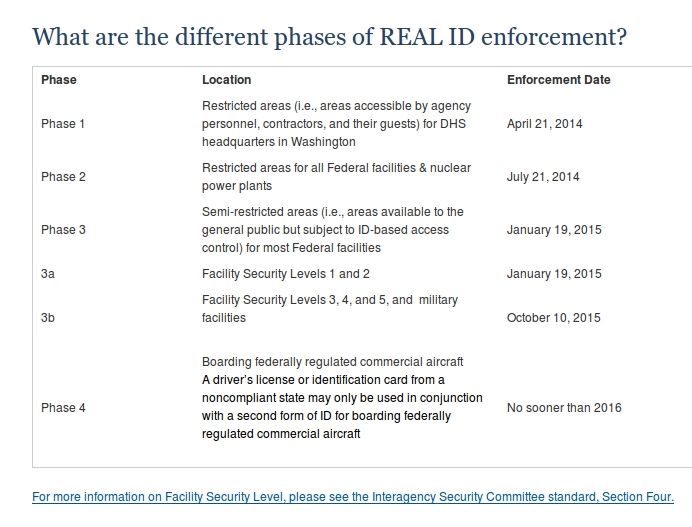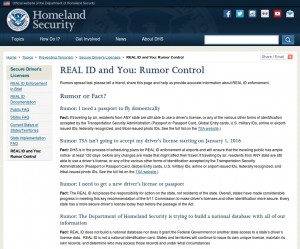The REAL-ID Act and entry to Federal facilities
Now that the DHS has postponed its self-imposed (and legally baseless) “deadline” for domestic air travelers to have ID that complies with the REAL-ID Act until at least 2020, the only threat left in the Federal arsenal to intimidate state governments into “compliance” with the REAL-ID Act any sooner than 2020 is the threat to bar residents of noncompliant states from access to some (but not most) Federal facilities, for some (but not most) purposes, in some (but not most) circumstances.
That was the subject of considerable discussion, and considerable confusion, at yesterday’s second meeting of the Minnesota Legislative Working Group on REAL-ID Compliance, which is trying to figure out how seriously to take this threat (short answer: not very) and whether it calls for immediate action (short answer: no).
What is the DHS really threatening to do? And how much effect will that have, or has it already had?
Like a typical extortionist, the DHS keeps its threats vague and changeable. In a response made public today to a disability-rights complaint that is already the subject of litigation, DHS officials declared that it is “not objectively reasonable” to take statements on TSA.gov at face value. That’s par for the course: The TSA has previosuly claimed that its own press statements are exempt from release in response to FOIA requests becuase it would “create public confusion” for the public to know the basis, if any, for those statements.
But what else can we do? In the absence of any laws or regulations requiring ID to fly or enter public buildings, and with the DHS having withheld most of its internal guidelines for building access from disclosure in response to our FOIA requests, all we have to go on are DHS rulemaking-by-press-release and reverse engineering of the secret DHS directives from anecdotal and observational evidence. If the DHS doesn’t want us to reverse-engineeer its secret rules from what we see happening on the ground, it can get Congress to enact those rules into public law, or publish them in the Federal Register as regulations.
The DHS claims on its official website that its REAL-ID Act “rules” (i.e. secret internal directives) for entry to Federal facilities went into effect on October 15, 2015. So if the sky were going to fall, we’d know about it already. It hasn’t. Reports of anyone being denied entry to a Federal facility have been rare.
As recently as November 22, 2015 — more than a month after the penultimate phase of REAL-ID Act enforcement had supposedly begun — the DHS public FAQ about the REAL-ID Act said that requirements for ID from compliant states would depend on the “Facility Security Level” (FSL) assigned to each facility:
All mention of these enforcement phases and this scheme of “Facility Security Levels” disappeared completely from this Web page sometime between November 22, 2015, and today. The DHS has since blocked the Internet Archive from its website, to avoid being questioned about unexplained changes like this.
Presumably, the DHS rescinded and tried to efface the memory of this security level sham because so few Federal facilities had actually been assigned an FSL that would have triggered REAL-ID Act compliance demands. When we filed FOIA requests for Federal facilities in the San Francisco Bay Area, we found that none of the the most conspicuous potential Federal terrorist targets and critical infrastructure facilities in our region had been assigned any FSL at all.
FSL assignments were supposed to be the “security assessments” justifying ID demands. The ability of the DHS to wipe out this whole scheme by fiat, overnight, merely by revising a website and without any rulemaking or public explanation, exemplifies the fact that all of the supposed “deadlines” for REAL-ID Act compliance are equally arbitrary, discretionary, and changeable at the whim of the DHS or its master or mistress in the White House.
(The latest postponement of the “deadline” for compliant ID to fly to October 1, 2020 is particularly incredible. Whatever administration is in power on that date is not going to start barring residents of any state from flying, a month before the 2020 Presidential and Congressional elections. To do so would be electoral suicide. If the REAL-ID Act hasn’t been repealed or overtuened by the courts by then, you can count on the DHS postponing that “deadline” again.)



